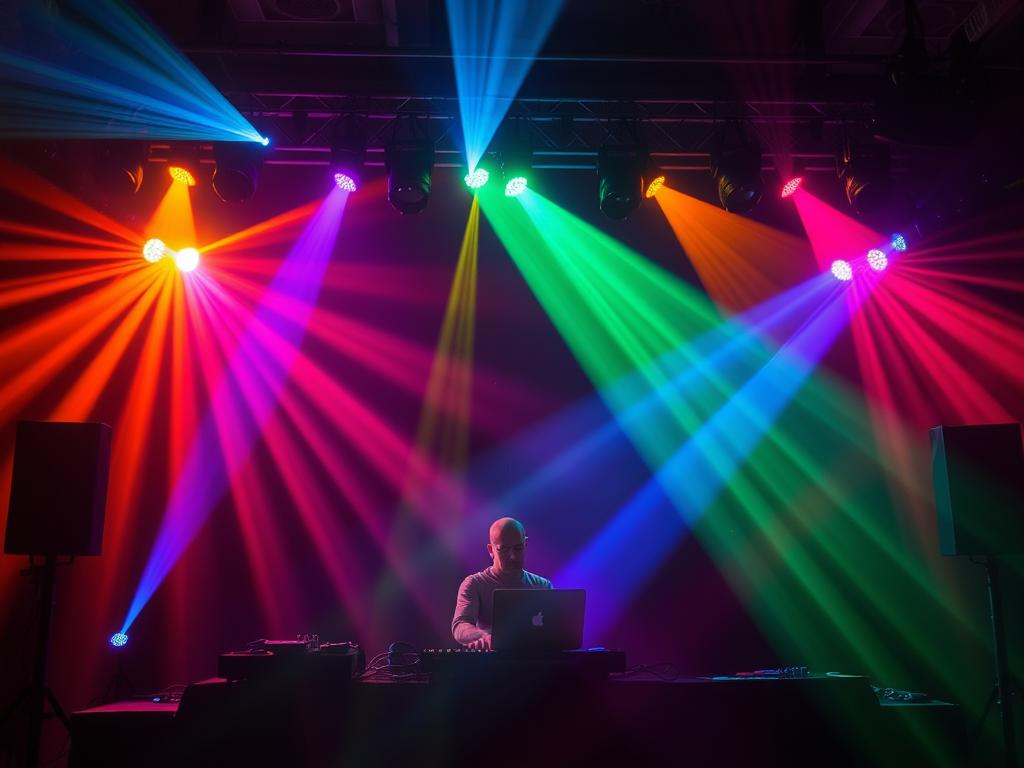
Spot vs Beam Moving Head Lights: Key Differences Explained
, by Katy Chen, 12 min reading time

, by Katy Chen, 12 min reading time
The main difference between Spot and Beam Moving Head Lights is the beam angle: Spot lights have wider adjustable beams for gobo projection, while Beam lights create narrow, intense shafts for dramatic aerial effects. Choosing the right type can completely transform your lighting design and dramatically impact the atmosphere of your event.

Spot moving head lights are versatile fixtures that produce a focused beam of light in a cone-like shape. Think of them as the sophisticated cousins of your household flashlight – but with incredible precision, movement capabilities, and creative features.

These fixtures typically feature a small lens and a single high-powered LED or lamp that creates a defined beam. What makes spot lights special is their ability to project gobos – stencil-like patterns that shape the light into stars, circles, logos, or custom designs.
Spot lights excel in applications where you need to highlight specific performers, project logos, or create textured lighting effects. They're the workhorses of theatrical productions, corporate events, and wedding receptions where precise control and pattern projection are essential.

Beam moving head lights are the laser pointers of the professional lighting world. They produce incredibly narrow, intense shafts of light that cut through darkness and atmospheric effects with stunning precision.

These fixtures utilize specialized optics to create the tightest ray of solid light possible. The result is a powerful, well-defined beam that can travel impressive distances without dispersing significantly. The intensity of these lights often depends on their power, so it's useful to understand the difference between 230W, 400W, and 600W models.
Beam lights truly shine when used with atmospheric effects like haze or fog. The narrow shaft of light becomes visible in the air itself, creating those iconic light tunnels and aerial effects you've seen at concerts and festivals. Without haze, you'll only see the small point where the beam hits a surface.

| Feature | Spot Moving Head | Beam Moving Head |
|---|---|---|
| Beam Angle | 15° to 50° (adjustable) | 2° to 5° (very narrow) |
| Gobo Projection | Yes - patterns and effects | Limited or none |
| Best Effect | Surface projection, texture | Aerial effects, light tunnels |
| Atmospheric Need | Works well without haze | Requires haze/fog for full effect |
| Typical Applications | Theaters, weddings, corporate | Concerts, clubs, EDM events |
| Versatility | Higher (more features) | More specialized |

The primary distinction between these two moving head types comes down to their intended purpose. Spot lights are versatile workhorses that excel at pattern projection and area highlighting, while beam lights are specialists in creating those jaw-dropping aerial effects that define big productions.
Selecting between spot and beam moving head lights depends entirely on your specific needs and the type of events you typically handle. For a complete buyer's guide, check out our article on how to choose the best moving head beam light.

Budget is another consideration. Spot fixtures often cost more than beam fixtures of similar quality because they typically include more features like gobo wheels, prisms, and zoom capabilities. However, they also offer more versatility for the investment.
Our lighting experts can help you choose the perfect fixtures based on your venue size, event types, and budget. Get personalized recommendations!
Get Expert Advice via WhatsAppNot really. While some high-end spot fixtures have a narrow zoom range that can approach beam-like effects, they won't achieve the same intensity and tightness that dedicated beam fixtures provide. The optics and design are fundamentally different. If you need true beam effects, it's best to invest in a proper beam fixture.
Absolutely! In fact, this is the ideal approach for a versatile lighting setup. Use spot fixtures for pattern projection, area highlighting, and general coverage, then add beam fixtures for those dramatic aerial effects and eye-candy moments. This combination gives you the best of both worlds and allows for more dynamic lighting designs.
For their signature aerial effects, yes. Without atmospheric haze or fog, you'll only see the small point where the beam hits a surface, missing the dramatic "light tunnel" effect that makes beam fixtures so popular. If you regularly work in venues that don't allow atmospheric effects, spot fixtures might be a better investment.
Hybrid fixtures that combine spot, beam, and sometimes wash capabilities in one unit are becoming increasingly popular. They offer versatility but often with some compromise in performance compared to dedicated fixtures. They're excellent for mobile DJs and smaller production companies looking to maximize versatility while minimizing inventory.
If your budget allows, the ideal approach is to include both spot and beam moving head lights in your inventory. This combination provides maximum versatility and allows you to create truly dynamic lighting designs for any event type.
Start with quality spot fixtures as your foundation, then add beam fixtures to create those wow moments that clients and audiences remember. For the most impressive results, pair your moving heads with proper atmospheric haze (not fog) to make every beam visible and enhance the overall impact of your lighting design.

Browse our collection of professional-grade moving head beam lights. From compact units for mobile DJs to powerful fixtures for large venues, we have options for every need and budget.
Shop Moving Head LightsNeed a custom quote or have questions? Our lighting experts are ready to help!
Contact Us on WhatsApp